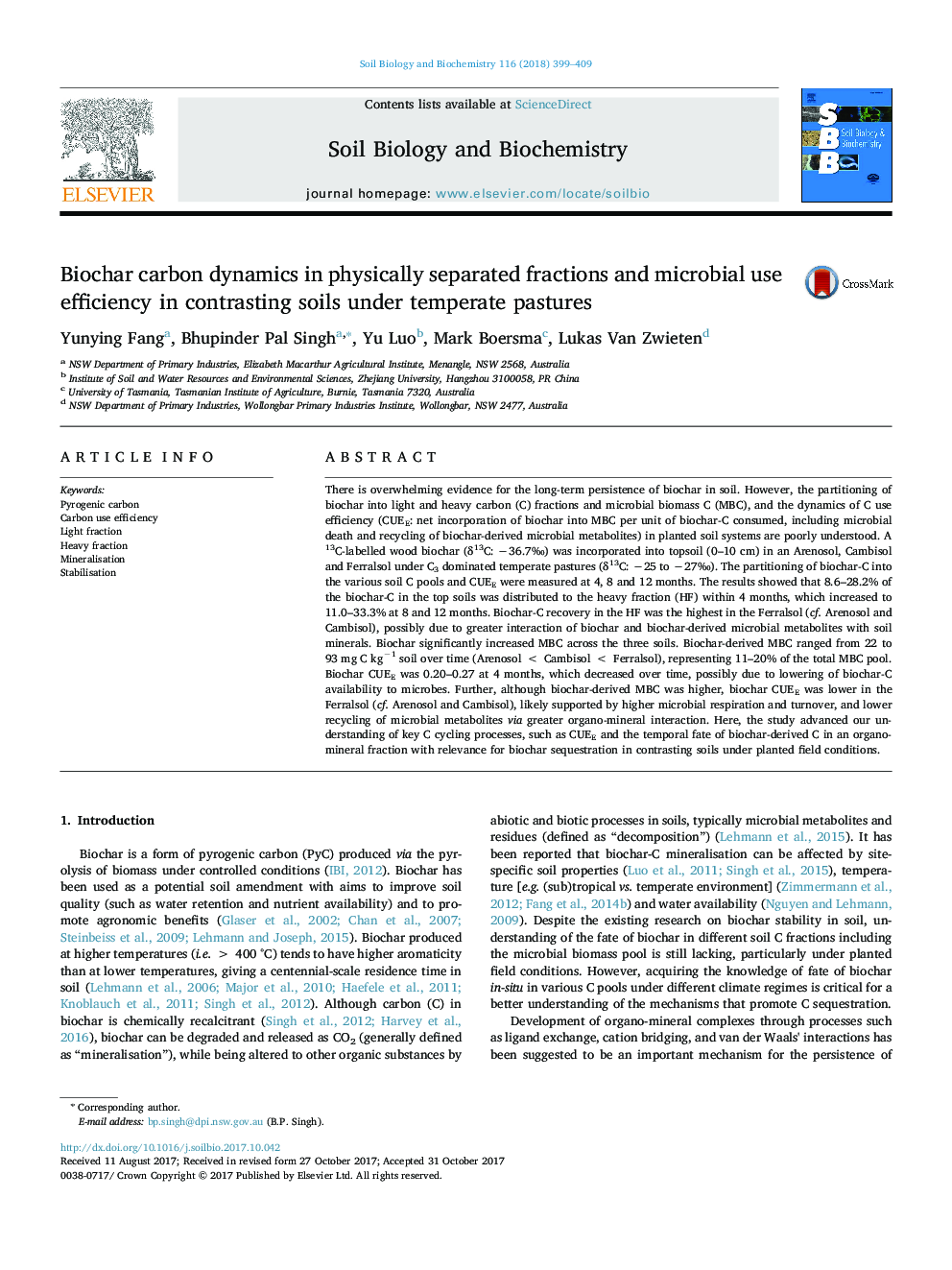| کد مقاله | کد نشریه | سال انتشار | مقاله انگلیسی | نسخه تمام متن |
|---|---|---|---|---|
| 8363158 | 1542568 | 2018 | 11 صفحه PDF | دانلود رایگان |
عنوان انگلیسی مقاله ISI
Biochar carbon dynamics in physically separated fractions and microbial use efficiency in contrasting soils under temperate pastures
ترجمه فارسی عنوان
پویایی کربن بیوکار در فیزیکدانهای جدا شده فیزیکی و بهره وری استفاده از میکروبی در مخلوط خاک در مراتع معتدل
دانلود مقاله + سفارش ترجمه
دانلود مقاله ISI انگلیسی
رایگان برای ایرانیان
کلمات کلیدی
کربن پریروزیک، کارآیی کربن، کسر نور، کسر سنگین، معدنی شدن، پایدارسازی،
موضوعات مرتبط
علوم زیستی و بیوفناوری
علوم کشاورزی و بیولوژیک
دانش خاک شناسی
چکیده انگلیسی
There is overwhelming evidence for the long-term persistence of biochar in soil. However, the partitioning of biochar into light and heavy carbon (C) fractions and microbial biomass C (MBC), and the dynamics of C use efficiency (CUEE: net incorporation of biochar into MBC per unit of biochar-C consumed, including microbial death and recycling of biochar-derived microbial metabolites) in planted soil systems are poorly understood. A 13C-labelled wood biochar (δ13C: â36.7â°) was incorporated into topsoil (0-10 cm) in an Arenosol, Cambisol and Ferralsol under C3 dominated temperate pastures (δ13C: â25 to â27â°). The partitioning of biochar-C into the various soil C pools and CUEE were measured at 4, 8 and 12 months. The results showed that 8.6-28.2% of the biochar-C in the top soils was distributed to the heavy fraction (HF) within 4 months, which increased to 11.0-33.3% at 8 and 12 months. Biochar-C recovery in the HF was the highest in the Ferralsol (cf. Arenosol and Cambisol), possibly due to greater interaction of biochar and biochar-derived microbial metabolites with soil minerals. Biochar significantly increased MBC across the three soils. Biochar-derived MBC ranged from 22 to 93 mg C kgâ1 soil over time (Arenosol < Cambisol < Ferralsol), representing 11-20% of the total MBC pool. Biochar CUEE was 0.20-0.27 at 4 months, which decreased over time, possibly due to lowering of biochar-C availability to microbes. Further, although biochar-derived MBC was higher, biochar CUEE was lower in the Ferralsol (cf. Arenosol and Cambisol), likely supported by higher microbial respiration and turnover, and lower recycling of microbial metabolites via greater organo-mineral interaction. Here, the study advanced our understanding of key C cycling processes, such as CUEE and the temporal fate of biochar-derived C in an organo-mineral fraction with relevance for biochar sequestration in contrasting soils under planted field conditions.
ناشر
Database: Elsevier - ScienceDirect (ساینس دایرکت)
Journal: Soil Biology and Biochemistry - Volume 116, January 2018, Pages 399-409
Journal: Soil Biology and Biochemistry - Volume 116, January 2018, Pages 399-409
نویسندگان
Yunying Fang, Bhupinder Pal Singh, Yu Luo, Mark Boersma, Lukas Van Zwieten,
